4-1BB signaling synergizes with programmed death ligand 1 blockade to augment CD8 T cell responses during chronic viral infection
- PMID: 21742975
- PMCID: PMC4404506
- DOI: 10.4049/jimmunol.1100077
4-1BB signaling synergizes with programmed death ligand 1 blockade to augment CD8 T cell responses during chronic viral infection
Abstract
Previous studies have identified the inhibitory role that the programmed death 1 (PD-1) pathway plays during chronic infection. Blockade of this pathway results in rescue of viral-specific CD8 T cells, as well as reduction of viral loads in mice chronically infected with lymphocytic choriomeningitis virus (LCMV). We tested the effect of combining PD ligand 1 (PD-L1) blockade with an agonistic regimen that induces 4-1BB costimulation during chronic LCMV infection. There is a boosting effect in the rescue of LCMV-specific CD8 T cell responses after dual treatment with PD-L1 blockade and 4-1BB agonistic Abs when the amount and timing of 4-1BB costimulation are carefully controlled. When PD-L1-blocking Abs are given together with a single low dose of anti-4-1BB agonistic Abs, there is an enhanced and stable expansion of viral-specific CD8 T cells. Conversely, when blocking Abs to PD-L1 are given with a repetitive high dose of anti-4-1BB, there is an initial synergistic expansion of viral-specific CD8 T cells by day 7, followed by dramatic apoptosis by day 14. Viral control paralleled CD8 T cell kinetics after dual treatment. By day 7 posttreatment, viral titers were lower in both of the combined regimens (compared with PD-L1 blockade alone). However, whereas the high dose of anti-4-1BB plus PD-L1 blockade resulted in rebound of viral titers to original levels, the low dose of anti-4-1BB plus PD-L1 blockade resulted in a stable reduction of viral loads. These findings demonstrate the importance of carefully manipulating the balance between activating and inhibitory signals to enhance T cell responses during chronic infection.
Conflict of interest statement
R.A., G.J.F., D.L.B., and S.-J.H. have patents and receive patent royalties related to the PD-1 pathway. The other authors have no financial conflicts of interest.
Figures
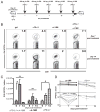
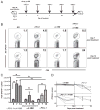
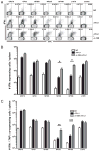
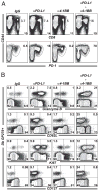
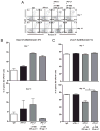
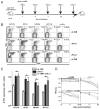
Similar articles
-
PD-L1 Checkpoint Inhibition Narrows the Antigen-Specific T Cell Receptor Repertoire in Chronic Lymphocytic Choriomeningitis Virus Infection.J Virol. 2020 Aug 31;94(18):e00795-20. doi: 10.1128/JVI.00795-20. Print 2020 Aug 31. J Virol. 2020. PMID: 32641478 Free PMC article.
-
Tissue-specific differences in PD-1 and PD-L1 expression during chronic viral infection: implications for CD8 T-cell exhaustion.J Virol. 2010 Feb;84(4):2078-89. doi: 10.1128/JVI.01579-09. Epub 2009 Dec 2. J Virol. 2010. PMID: 19955307 Free PMC article.
-
Interplay between regulatory T cells and PD-1 in modulating T cell exhaustion and viral control during chronic LCMV infection.J Exp Med. 2014 Aug 25;211(9):1905-18. doi: 10.1084/jem.20132577. Epub 2014 Aug 11. J Exp Med. 2014. PMID: 25113973 Free PMC article.
-
Reinvigorating exhausted HIV-specific T cells via PD-1-PD-1 ligand blockade.J Exp Med. 2006 Oct 2;203(10):2223-7. doi: 10.1084/jem.20061800. Epub 2006 Sep 25. J Exp Med. 2006. PMID: 17000870 Free PMC article. Review.
-
Manipulating both the inhibitory and stimulatory immune system towards the success of therapeutic vaccination against chronic viral infections.Immunol Rev. 2008 Jun;223:317-33. doi: 10.1111/j.1600-065X.2008.00638.x. Immunol Rev. 2008. PMID: 18613845 Review.
Cited by
-
The risks of targeting co-inhibitory pathways to modulate pathogen-directed T cell responses.Trends Immunol. 2013 May;34(5):193-9. doi: 10.1016/j.it.2012.12.002. Epub 2013 Jan 16. Trends Immunol. 2013. PMID: 23333205 Free PMC article. Review.
-
Agonist Antibodies for Cancer Immunotherapy: History, Hopes, and Challenges.Clin Cancer Res. 2024 May 1;30(9):1712-1723. doi: 10.1158/1078-0432.CCR-23-1014. Clin Cancer Res. 2024. PMID: 38153346 Free PMC article. Review.
-
4-1BB Delineates Distinct Activation Status of Exhausted Tumor-Infiltrating CD8+ T Cells in Hepatocellular Carcinoma.Hepatology. 2020 Mar;71(3):955-971. doi: 10.1002/hep.30881. Epub 2019 Oct 18. Hepatology. 2020. PMID: 31353502 Free PMC article.
-
Controlling viral inflammatory lesions by rebalancing immune response patterns.Front Immunol. 2023 Aug 21;14:1257192. doi: 10.3389/fimmu.2023.1257192. eCollection 2023. Front Immunol. 2023. PMID: 37671156 Free PMC article. Review.
-
Cancer and HIV-1 Infection: Patterns of Chronic Antigen Exposure.Front Immunol. 2020 Jun 30;11:1350. doi: 10.3389/fimmu.2020.01350. eCollection 2020. Front Immunol. 2020. PMID: 32714330 Free PMC article. Review.
References
-
- Barber DL, Wherry EJ, Masopust D, Zhu B, Allison JP, Sharpe AH, Freeman GJ, Ahmed R. Restoring function in exhausted CD8 T cells during chronic viral infection. Nature. 2006;439:682–687. - PubMed
-
- Day CL, Kaufmann DE, Kiepiela P, Brown JA, Moodley ES, Reddy S, Mackey EW, Miller JD, Leslie AJ, DePierres C, et al. PD-1 expression on HIV-specific T cells is associated with T-cell exhaustion and disease progression. Nature. 2006;443:350–354. - PubMed
Publication types
MeSH terms
Substances
Grants and funding
LinkOut - more resources
Full Text Sources
Other Literature Sources
Molecular Biology Databases
Research Materials

